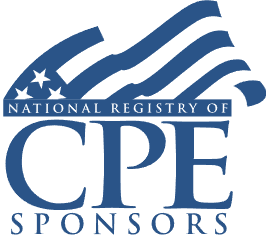Year-End Charitable Planning After Tax Reform: Qualified IRA Distributions, Stacking Strategies, Income Shifting
TBD

Course Details
- smart_display Format
On-Demand
- signal_cellular_alt Difficulty Level
Intermediate
- work Practice Area
Tax Preparer
- event Date
Tuesday, December 11, 2018
- schedule Time
1:00 PM E.T.
- timer Program Length
110 minutes
-
BARBRI is a NASBA CPE sponsor and this 110-minute webinar is accredited for 2.0 CPE credits.
-
BARBRI is an IRS-approved continuing education provider offering certified courses for Enrolled Agents (EA) and Tax Return Preparers (RTRP).
-
Live Online
On Demand
This course will provide fiduciaries and their tax advisers with a thorough and practical guide to year-end charitable planning in the wake of the 2017 tax overhaul. The panel will detail which charitable vehicles provide maximum tax savings after tax reform law, focusing on qualified charitable distributions from IRAs, complex trust transfers, and the impact of rising interest rates on various charitable trust structures.
Description
The 2017 tax reform law altered the landscape of charitable contributions, reducing tax incentives for some taxpayers making charitable donations while encouraging those contributions for others. Tax advisers performing year-end charitable planning must take note of the impact of the law on charitable contributions, particularly for taxpayers eligible for RMDs from their qualified accounts and those with existing charitable trusts.
Two elements of the tax law have a specific impact on taxpayers' charitable giving. The increased standard deduction will often lessen the tax benefit of charitable contributions for some taxpayers. In some cases, this will also apply to the jump in the federal transfer tax exemption amount. Charitably inclined taxpayers may need to consider strategies such as multi-year "stacking" to maximize tax advantages from charitable donations they intended to make in any case.
The law also extends the provision allowing taxpayers aged 70-1/2, who are subject to RMD rules, to treat a qualified charitable distribution as a non-taxable rollover. The QCD rules are specific as to which recipients are eligible for rollover treatment.
The new law also creates advantaged—and disadvantaged—trust structures for making contributions. Taxpayers should focus on shifting income to complex trusts to maximize the benefits of charitable giving. Further, rising interest rates benefit structures such as CRATs, GRITs and QPRTs, while lessening the benefits of others such as CLATs and GRATs.
Listen as our expert panel provides a thorough and practical guide to charitable tax planning after the 2017 tax overhaul.
Outline
- Key changes in 2017 tax reform law impacting tax benefits of charitable giving
- Increased standard deduction
- Repeal of Pease limitations
- Increased exemption amount for transfer taxes
- Qualified charitable distributions from IRAs
- Who can make them
- RMD calculations
- Ineligible recipients
- Shifting income to complex/non-grantor trusts
- "Stacking" of charitable contributions
- Trust structures and strategies
- Planning around possible repeal
- Risks and disallowed deductions
Benefits
The panel will discuss these and other relevant topics:
- Using stacking or bunching strategies to maximize tax benefits by concentrating planned gifts in a single tax year
- Enhanced benefits of using qualified charitable distributions from IRAs to eliminate the tax bite of an RMD
- Benefits of shifting income to a complex/non-grantor trust to maximize tax savings on charitable gifts
- Impact of rising interest rates on charitable trust structures
NASBA Details
Learning Objectives
After completing this course, you will be able to:
- Design tax-advantaged charitable contribution strategies using trusts and RMDs from IRAs
- Recognize how rising interest rates will make certain charitable trust structures more tax-advantaged than others
- Identify charitable distributions from trusts that will not withstand IRS scrutiny
- Using power of attorney provisions to enable tax-deductible charitable contributions in the event of settlor incapacity
- Field of Study: Taxes
- Level of Knowledge: Intermediate
- Advance Preparation: None
- Teaching Method: Seminar/Lecture
- Delivery Method: Group-Internet (via computer)
- Attendance Monitoring Method: Attendance is monitored electronically via a participant's PIN and through a series of attendance verification prompts displayed throughout the program
- Prerequisite: Three years+ business or public firm experience at mid-level within the organization, doing estate plans for high net worth individuals; supervisory authority over other preparers/accountants. Knowledge and understanding of trusts within estate planning, IRAs and Roth IRA plans

Strafford Publications, Inc. is registered with the National Association of State Boards of Accountancy (NASBA) as a sponsor of continuing professional education on the National Registry of CPE Sponsors. State boards of Accountancy have final authority on the acceptance of individual courses for CPE Credits. Complaints regarding registered sponsons may be submitted to NASBA through its website: www.nasbaregistry.org.

Strafford is an IRS-approved continuing education provider offering certified courses for Enrolled Agents (EA) and Tax Return Preparers (RTRP).
Unlimited access to premium CLE courses:
- Annual access
- Available live and on-demand
- Best for attorneys and legal professionals
Unlimited access to premium CPE courses.:
- Annual access
- Available live and on-demand
- Best for CPAs and tax professionals
Unlimited access to premium CLE, CPE, Professional Skills and Practice-Ready courses.:
- Annual access
- Available live and on-demand
- Best for legal, accounting, and tax professionals
Unlimited access to Professional Skills and Practice-Ready courses:
- Annual access
- Available on-demand
- Best for new attorneys
Related Courses
Recommended Resources
How CPE Can Bridge the Gap Between What You Know and What You Need to Know
- Career Advancement
